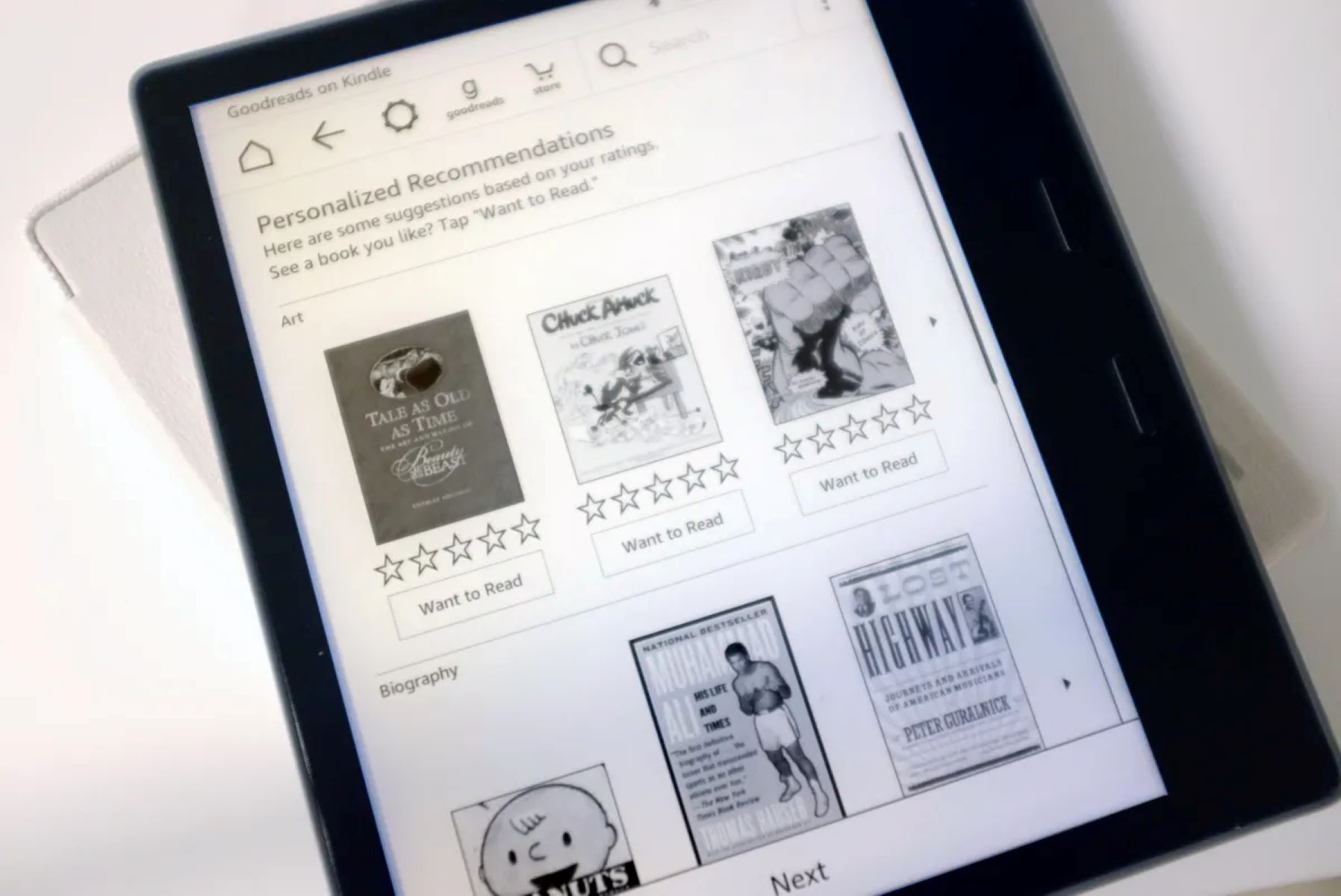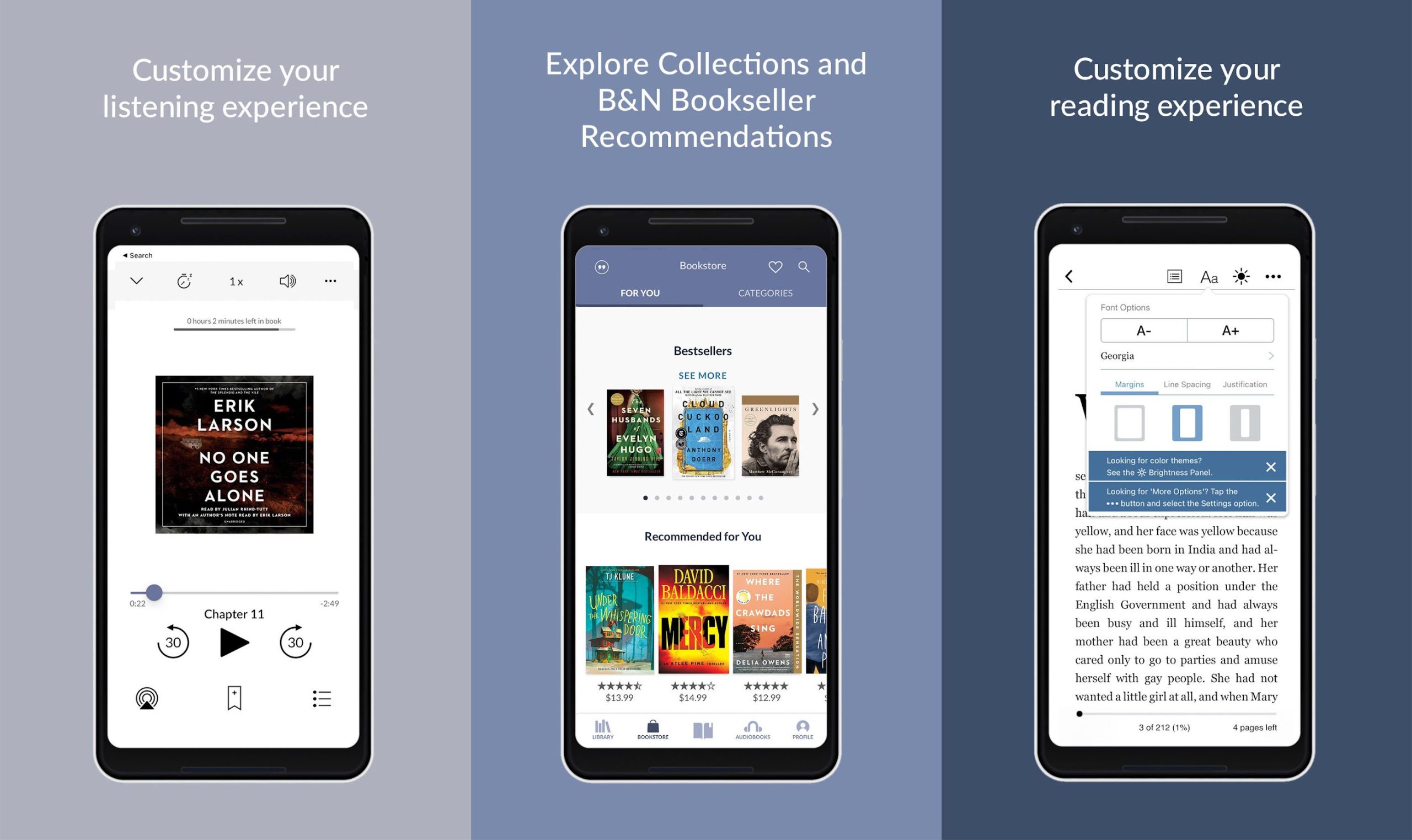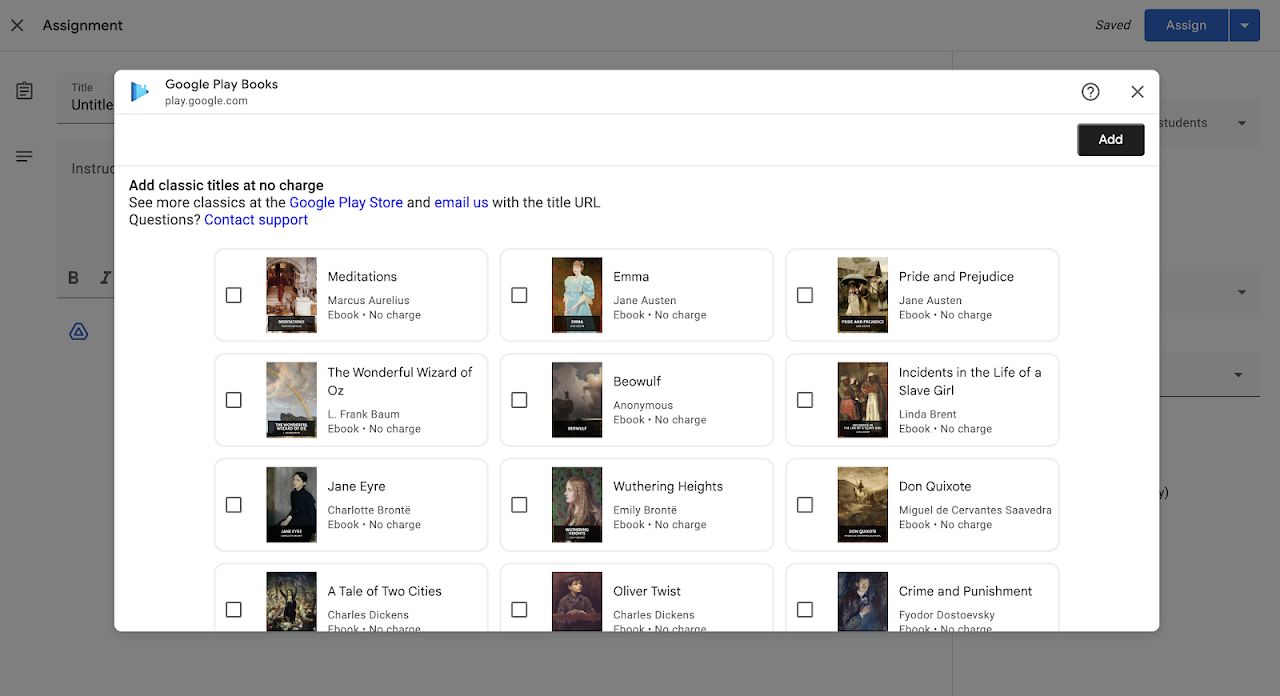Introduction
Welcome to the world of eBooks! With the digital revolution, reading has taken on a whole new form, allowing us to conveniently carry an entire library in our pockets. Whether you’re an avid reader or just getting started, buying eBooks provides a world of literary possibilities at your fingertips.
In this article, we will guide you through the process of purchasing eBooks, ensuring that you find the perfect ones to suit your interests and preferences. From choosing the right eBook to making the purchase and managing your eBook library, we’ll cover all the essential steps to help you navigate this exciting digital realm.
Before diving into the detailed steps, it’s important to note that eBooks come in various formats, and not all platforms and devices support every format. Understanding the different formats and their compatibility with your desired reading device is crucial for a smooth and enjoyable eBook reading experience.
Additionally, it’s helpful to familiarize yourself with reputable eBook retailers that offer a wide range of titles and fair pricing. Comparing prices, reading reviews, and checking for deals can go a long way in ensuring you make informed choices and get the most out of your eBook purchases.
So, whether you’re looking for a thrilling mystery, a thought-provoking non-fiction, or a classic novel, let’s embark on this journey together and learn how to buy eBooks. Get ready to discover a world of literary wonders right at your fingertips!
Choosing the Right eBook
When it comes to choosing the right eBook, there are a few factors to consider that will ensure you have an engaging and enjoyable reading experience. Here are some tips to help you make the right choice:
- Identify your interests: Determine the genre or topic that piques your curiosity. Are you in the mood for a thrilling mystery, a heartwarming romance, or a captivating science fiction adventure? Knowing your preferences will help you narrow down your search.
- Read book descriptions and summaries: Take the time to read the book descriptions and summaries provided by the retailer or author. This will give you a better understanding of the plot, characters, and themes in the book, allowing you to make an informed decision.
- Consider recommendations: Seek recommendations from friends, family, or online communities. Reading reviews and testimonials from other readers can give you valuable insights into the quality and appeal of a particular eBook.
- Sample the eBook: Many eBook platforms offer the option to sample a portion of the book before purchasing. Take advantage of this feature to get a feel for the writing style and determine if it resonates with you.
- Check for series or sequels: If you enjoy a particular book, check if it is part of a series or has sequels. This gives you the opportunity to delve deeper into the story and spend more time with characters you love.
- Consider your reading device: Keep in mind the capabilities of your reading device. Some eBooks may contain interactive elements or multimedia content that require specific devices or apps. Make sure your device supports the necessary features for the best reading experience.
- Think about accessibility: If you have any specific accessibility needs, such as large text size, text-to-speech capabilities, or screen reader compatibility, look for eBooks that offer these features to make your reading experience more comfortable.
- Follow your intuition: Ultimately, trust your instincts and choose eBooks that resonate with you on a personal level. Sometimes, a gut feeling can lead to discovering a hidden gem that becomes a cherished favorite.
By considering these factors and taking the time to explore different options, you can ensure that you choose eBooks that align with your interests and preferences. So, get ready to embark on new literary adventures and dive into the captivating world of eBooks!
Researching eBook Formats
Before purchasing an eBook, it’s essential to understand the different formats available and ensure compatibility with your preferred reading device. Here’s a brief overview of the most common eBook formats:
1. EPUB: EPUB is the most widely used eBook format that is compatible with a variety of devices, including e-readers, tablets, and smartphones. It offers dynamic text formatting, adjustable font sizes, and reflowable content, providing a seamless reading experience across different screen sizes.
2. PDF: PDF (Portable Document Format) is a popular format known for its fixed layout, preserving the original formatting and design of the eBook. It’s suitable for eBooks with complex layouts, such as textbooks, magazines, and graphic novels. However, PDFs may not adapt well to smaller screens and can be less flexible for adjusting font sizes.
3. MOBI: MOBI (Mobipocket) is primarily used with Amazon Kindle devices and applications. It offers a similar reading experience to EPUB, but with some differences in formatting and features. If you own a Kindle device, make sure the eBooks you want to purchase are available in MOBI format.
4. AZW: AZW is a proprietary eBook format developed by Amazon. It is specifically designed for use with Kindle devices and apps. If you solely use Kindle products, ensure the eBooks you choose are in AZW format to ensure optimal compatibility.
5. Other formats: There are additional eBook formats, such as LIT, TXT, and HTML, among others. These formats may have more limited compatibility with specific devices or applications.
To determine which format is suitable for your reading device, check the device specifications or consult the manufacturer’s website. Most eBook retailers provide information on the supported formats for each device they sell. It’s also worth noting that many e-readers and reading apps can handle multiple formats, offering flexibility in your eBook choices.
Keep in mind that DRM (Digital Rights Management) may be applied to certain eBooks, restricting their use to designated devices or applications. It’s important to check if the eBook you want to purchase has DRM and if it aligns with your preferred reading setup.
By researching eBook formats and ensuring compatibility with your device, you can make informed decisions when purchasing eBooks and enjoy a seamless reading experience.
Selecting a Platform or Device
When it comes to buying and reading eBooks, selecting the right platform or device is crucial for a seamless and enjoyable experience. Here are some factors to consider when choosing your platform or device:
1. E-Reader Devices: E-readers, such as Amazon Kindle, Kobo, or Barnes & Noble Nook, are dedicated devices designed specifically for reading eBooks. They offer features like E Ink displays, long battery life, and easy-on-the-eyes reading experience. Consider factors like screen size, weight, and storage capacity when choosing an e-reader.
2. Tablets and Smartphones: Tablets and smartphones provide a more versatile reading experience as they can run dedicated e-reader apps, such as Kindle, Kobo, or Apple Books. They offer the added benefit of a color display, multi-functionality, and the convenience of carrying your entire library in one device.
3. Desktop and Laptop Computers: If you prefer reading on a larger screen or enjoy the comfort of reading on your computer, desktop and laptop computers are viable options. You can use e-reader software like Adobe Digital Editions or Kindle for PC to access and read eBooks.
4. Compatibility: Ensure that the platform or device you choose is compatible with the eBook formats you are interested in. Check if it supports popular eBook formats like EPUB or Kindle formats, as well as any specific DRM (Digital Rights Management) requirements.
5. Availability: Consider the availability and accessibility of eBooks on different platforms. Some platforms may have a larger selection and exclusive deals, while others might have a more limited selection. Research and compare different platforms to find one that offers the eBooks you want.
6. User Experience: Test out the user interface and reading experience of different platforms or devices. Look for features like adjustable font sizes, bookmarking, highlighting, and note-taking capabilities, as these can enhance your reading experience and make it more personalized.
7. Cost: Consider the cost of the platform or device as well as the pricing of eBooks. Some platforms or devices might have cheaper eBook options, while others may have a larger selection of free or discounted eBooks. Compare prices and deals to find the most budget-friendly option.
These factors will help you make an informed decision when selecting a platform or device for your eBook reading. Remember that each option has its own advantages and trade-offs, so choose the one that aligns with your preferences and reading habits. With the right platform or device, you’ll be ready to dive into the world of eBooks!
Finding Reliable eBook Retailers
When it comes to buying eBooks, finding reliable eBook retailers is essential to ensure a secure and satisfactory purchase experience. Here are some tips to help you find reputable eBook retailers:
1. Established Online Booksellers: Start by exploring established online booksellers like Amazon, Barnes & Noble, or Kobo. These platforms have extensive collections of eBooks, offer user-friendly interfaces, and often provide customer reviews and ratings to help you make informed purchasing decisions.
2. Publisher Websites: Visit the websites of established publishers in your preferred genre to discover a wide range of eBooks. Many publishers offer direct sales of eBooks, ensuring that you’re purchasing from a reliable and authorized source.
3. Public Libraries: Check if your local public library offers an eBook lending service. Many libraries now provide digital platforms where you can borrow eBooks for a limited period. It’s a cost-effective way to access a vast collection of eBooks without purchasing them individually.
4. Online Communities and Forums: Join online communities and forums dedicated to eBook readers. These platforms are excellent sources for recommendations, deals, and discovering lesser-known eBook retailers. However, exercise caution and verify the credibility of the suggested retailers before making purchases.
5. Author Websites: Visit the websites or author pages of your favorite writers. Many authors sell their eBooks directly, providing a chance to support them while ensuring a reliable purchase. Plus, you might find exclusive deals or discounts when buying directly from the author.
6. Online Marketplaces: Explore online marketplaces like eBay or Etsy, where independent authors and small publishers may offer their eBooks for sale. While these platforms can provide unique and niche content, exercise caution and check the seller’s reputation and customer reviews before making a purchase.
7. Customer Reviews and Ratings: Before purchasing an eBook, read customer reviews and ratings to gauge the quality of the book and the reliability of the retailer. Multiple positive reviews and high ratings indicate a trustworthy retailer with a satisfied customer base.
8. Refunds and Return Policies: Check if the eBook retailer offers a refund or return policy in case you change your mind or encounter any issues with your purchase. A reputable retailer will have fair and transparent policies to address customer concerns.
9. Secure Payment Options: Ensure that the eBook retailer provides secure payment options to protect your personal and financial information. Look for SSL encryption and trusted payment gateways like PayPal or credit card processors to ensure a safe transaction.
By considering these tips, you can find reliable eBook retailers that offer a wide selection of titles, fair pricing, and a secure purchasing experience. Take your time to explore different options, read reviews, and ultimately choose the retailers that align with your preferences and provide a seamless eBook shopping experience.
Comparing Prices and Deals
When it comes to buying eBooks, comparing prices and deals can help you make the most of your budget and discover great bargains. Here are some strategies for comparing prices and finding the best deals:
1. Check Multiple Retailers: Don’t settle for the first eBook retailer you come across. Explore multiple platforms and compare prices for the same eBook. Different retailers may offer varying prices, promotions, or exclusive discounts, allowing you to find the best deal.
2. Sign Up for Newsletters: Consider subscribing to newsletters or following the social media accounts of eBook retailers. Often, they send out promotional offers, discounts, and limited-time deals exclusively to their subscribers or followers. This gives you the opportunity to snag eBooks at discounted prices.
3. Look for Daily Deals: Many eBook retailers have a section dedicated to daily or weekly deals where you can find popular eBooks at significantly reduced prices. Keep an eye on these sections to catch limited-time offers and grab eBooks at discounted rates.
4. Free eBook Sections: Explore the free eBook sections of various platforms. Retailers often offer a selection of free eBooks, especially for classic literature or new authors trying to gain exposure. This allows you to expand your library without spending a dime.
5. Take Advantage of Bundles: Look for eBook bundles that combine multiple titles from the same author, series, or genre. Bundles often provide significant discounts compared to purchasing each eBook individually. It’s an excellent way to discover new authors or complete a series at a reduced price.
6. Utilize Price Comparison Sites and Apps: Use price comparison websites or apps specifically designed for eBooks. These platforms aggregate prices from different retailers, allowing you to quickly compare prices and identify the best deals without visiting each retailer individually.
7. Participate in eBook Sales and Promotions: Keep an eye out for seasonal sales, holiday promotions, or special events like eBook week or author anniversaries. Retailers often offer substantial discounts during these periods, giving you the chance to score eBooks at significantly lower prices.
8. Consider eBook Subscription Services: If you’re an avid reader who consumes multiple eBooks each month, consider subscribing to eBook subscription services like Kindle Unlimited or Scribd. These services offer unlimited access to a vast library of eBooks for a monthly fee.
By comparing prices, taking advantage of promotional deals, and exploring free or discounted eBook sections, you can maximize your eBook purchases and build an extensive collection without breaking the bank. Happy hunting for the best prices and deals!
Reading Reviews and Ratings
When purchasing an eBook, reading reviews and ratings can provide valuable insights into the quality and appeal of the book. Here’s why it’s important to consider reviews and ratings, and how to make the most of them:
1. Gauge Overall Reception: Reviews and ratings offer an overall assessment of the book’s reception by readers. Look for patterns in the reviews to get a sense of whether the book is well-received or has mixed reviews. This can help you decide if it aligns with your reading preferences.
2. Assess Writing Style and Plot: Reviews often touch upon the writing style, plot development, and storytelling abilities of the author. Pay attention to these aspects mentioned in the reviews to determine if they match your personal taste and expectations.
3. Consider Reader Relevance: Reviews can give you a sense of whether the book appeals to a specific audience or if it resonates with readers in a certain genre. If multiple reviewers mention that the book is suitable for your preferences, it could be a strong indication that you will enjoy it too.
4. Assess Consistency: Look for consistency in the reviews. If many reviews mention similar strengths or weaknesses, it can help you form a more accurate impression of the book. Determine what aspects are most important to you and weigh them based on the consistency of the reviews.
5. Identify Potential Triggers: Certain books may contain themes, content, or situations that might be uncomfortable or triggering for some readers. Reading reviews can help identify these potential triggers, allowing you to make an informed decision about whether the book is suitable for you.
6. Consider Reviewer Expertise: Pay attention to reviewers who have similar reading preferences or whose opinions you trust. If you find a reviewer whose recommendations align with your own, their insights can be highly valuable when selecting new eBooks.
7. Look for Balanced Reviews: Seek out reviews that present a balanced perspective, discussing both the strengths and weaknesses of the book. These reviews can provide a more comprehensive understanding of the book’s merits and limitations, allowing you to make a well-rounded decision.
8. Write Your Own Reviews: After reading an eBook, consider leaving your own reviews and ratings. Your feedback can help future readers make decisions and contribute to the eBook community by sharing your insights and opinions.
Keep in mind that individual preferences vary, and what works for one reader may not work for another. Therefore, it’s essential to consider reviews and ratings as a guide, but ultimately trust your own judgment and preferences when selecting an eBook to purchase.
By reading reviews and ratings, you can gain a better understanding of the eBook’s strengths, weaknesses, and its compatibility with your reading preferences. Embrace the wealth of knowledge shared by fellow readers to help you make informed decisions and discover new literary treasures. Happy reading!
Ensuring Compatibility
Before purchasing an eBook, it’s important to ensure compatibility with your chosen reading device or application. Here are some key considerations to ensure a seamless reading experience:
1. Supported Formats: Take note of the supported eBook formats for your reading device or application. Common formats include EPUB, PDF, MOBI, and AZW. Check the device specifications or consult the manufacturer’s website to confirm compatibility.
2. DRM (Digital Rights Management): Some eBooks are protected by DRM, which restricts their use to specific devices or applications. Ensure that your device or application supports the DRM system used by the eBook retailer. This information is typically specified on the retailer’s website or in the eBook’s description.
3. Device or Application Updates: Keep your reading device or application up to date. Regular updates often include bug fixes and improvements that enhance compatibility with different eBook formats. Check for available updates and install them to ensure optimal performance.
4. Reading Apps or Software: If you plan to read eBooks on a computer or mobile device, consider using a dedicated reading app or software. Applications like Kindle, Kobo, or Adobe Digital Editions provide a user-friendly interface and support multiple eBook formats, ensuring compatibility with a wide range of titles.
5. Screen Size and Formatting: Consider the screen size of your reading device or application and how it affects the formatting of eBooks. Complex layouts or graphics-intensive eBooks may not display properly on smaller screens. Adjust font sizes or use reflowable formats like EPUB for better readability across different screen sizes.
6. Interactive Features and Multimedia: Some eBooks contain interactive features or multimedia elements such as videos or audio files. Ensure that your device or application supports these features if you want to fully enjoy the intended reading experience.
7. Accessibility Features: If you have specific accessibility needs, such as large text size, text-to-speech capabilities, or screen reader compatibility, check if the reading device or application offers these features. Accessibility settings can greatly enhance your reading experience.
8. Syncing and Cloud Storage: Many reading devices and applications offer syncing capabilities and cloud storage. This allows you to access your eBooks across multiple devices or platforms. Make sure to set up syncing and back up your eBooks to ensure seamless access and synchronization.
9. Try Samples and Demos: Before purchasing an eBook, consider trying out samples or demos provided by eBook retailers or reading apps. This allows you to test compatibility and get a feel for how eBooks are displayed on your chosen device or application.
By considering these factors, you can ensure compatibility between your chosen reading device or application and the eBooks you purchase. Take the time to research, test, and explore different options to create a harmonious reading experience customized to your preferences.
Making the Purchase
Once you have decided on the eBook you want to buy, it’s time to make the purchase. Here’s a step-by-step guide to help you navigate the process and ensure a smooth transaction:
1. Add to Cart: On the eBook retailer’s website or app, locate the “Add to Cart” or “Buy Now” button next to the eBook you wish to purchase. Click on it to add the eBook to your virtual shopping cart.
2. Review Cart: Review the items in your shopping cart to ensure that you have selected the correct eBook and that the price is as expected. Take this opportunity to double-check your purchase before proceeding to the checkout.
3. Proceed to Checkout: Once you’re satisfied with your selections, proceed to the checkout. This will typically be a button or link on the cart page that takes you to the payment and delivery details section.
4. Enter Personal Information: Provide the necessary personal information, including your name, email address, and shipping address. If the eBook can be downloaded directly, the shipping address may not be required.
5. Choose Payment Method: Select your preferred payment method. Common options include credit/debit cards, PayPal, or digital wallets like Apple Pay or Google Pay. Ensure that the chosen payment method is secure and well-regarded.
6. Review Total Cost: Check the total cost of your purchase, which should include any applicable taxes or fees. Verify that the amount is correct before proceeding with the payment.
7. Apply Coupons or Gift Cards: If you have any valid coupons or gift cards, enter the necessary codes during the checkout process to apply the discounts. This step can help you save money on your eBook purchase.
8. Confirm and Place Order: Carefully review all the details, including the eBook title, price, and your personal information. If everything is correct, click on the “Confirm” or “Place Order” button to complete the transaction.
9. Access Download Link or Transfer to Device: After completing the purchase, you will typically receive a download link or instructions on how to access the eBook. Follow the provided steps to download the eBook to your device or transfer it to your preferred reading application.
10. Save Receipt: It’s a good practice to save a copy of the order confirmation or receipt for your records. This can be useful for reference or in case you need to contact customer support regarding your purchase.
By following these steps, you can confidently complete the eBook purchase process and begin reading your newly acquired title. Remember to keep track of your eBooks and manage your library effectively to ensure an organized and enjoyable reading experience.
Paying for the eBook
When it comes to purchasing an eBook, paying for your chosen title is a crucial step in the process. Here’s a guide on how to pay for your eBook securely and efficiently:
1. Choose a Trusted Payment Method: Select a payment method that is widely recognized and secure. Common options include credit/debit cards, PayPal, or digital wallets. Check for secure payment symbols or SSL encryption to ensure the safety of your financial information.
2. Enter Payment Details: Provide the required payment details, such as your card number, expiry date, and CVV code. If using digital wallets or PayPal, follow the prompts to log in and authorize the payment.
3. Verify Billing Information: Ensure that your billing information, such as your name and address, matches the details associated with your selected payment method. This helps prevent any payment processing issues.
4. Review the Total Amount: Double-check the total amount to be charged for the eBook purchase, including any applicable taxes or fees. Verify that the amount is correct and matches the price listed before proceeding with the payment.
5. Apply Gift Cards or Coupon Codes: If you have a gift card or a valid coupon code, apply it during the payment process to take advantage of discounts or promotions. Enter the provided code in the designated field and ensure that the discount is applied before finalizing the payment.
6. Confirm the Payment: Before finalizing the payment, review all the details, including the eBook title, price, and your payment information. Verify that everything is accurate before clicking the “Confirm” or “Place Order” button to authorize the payment.
7. Receive Confirmation: Once the payment is successfully processed, you will typically receive an order confirmation or receipt via email. Keep this for your records, as it serves as proof of purchase and can be helpful in case of any issues or inquiries regarding the transaction.
8. Check Payment Confirmation: Inspect your bank or credit card statement to ensure that the eBook purchase appears as expected. This helps verify that the payment went through correctly and that no unauthorized charges were made.
9. Report Any Payment Issues: If you encounter any payment issues, such as an error message or incorrect charges, contact the customer support of the eBook retailer immediately. Provide them with the necessary details and reference your order confirmation for efficient support.
10. Enjoy Your eBook: After successfully paying for your eBook, you can begin reading your purchase. Follow the provided instructions to access the download link or transfer the eBook to your preferred reading device or application.
By following these steps, you can securely and confidently complete the payment for your eBook, ensuring a smooth and hassle-free purchase experience. Happy reading!
Downloading the eBook
Once you have successfully purchased an eBook, the next step is to download it to your preferred reading device or application. Here’s a guide to help you download your eBook:
1. Check for Download Link: After completing the purchase, you will typically be directed to a confirmation page or receive an email with a download link. Click on the provided link to initiate the download process.
2. Choose the Correct Format: Sometimes, eBook retailers offer eBooks in multiple formats. Make sure to select the appropriate format that is compatible with your reading device or application. Refer to the supported formats section of your device’s manual or the retailer’s website for guidance.
3. Save the eBook File: When prompted, choose a location on your device or computer to save the eBook file. Select a folder or directory that you can easily locate later, as this is where you will access the eBook for reading.
4. Organize Your eBook Library: Consider creating a dedicated folder on your device or computer to store your eBook library. This can help you keep your eBooks organized and easily accessible whenever you want to read them.
5. Transfer to Reading Device: If you have a dedicated e-reader or reading device, follow the device’s specific instructions to transfer the downloaded eBook. This typically involves connecting the device to your computer via a USB cable and transferring the eBook file to a designated folder on the device.
6. Import into Reading Application: If you’re using a reading application on your tablet, smartphone, or computer, open the application and look for the import or open file option. Navigate to the location where you saved the eBook file and select it to import it into the application.
7. Sync Your eBook Library: If you have a reading application that supports cloud storage or syncing, ensure that your eBook library is synced across all your devices. This allows you to seamlessly access your eBooks from different devices without the need to transfer the files manually.
8. Test the eBook: Open the eBook on your reading device or application and ensure that it displays properly. Check if the formatting, fonts, and images appear as intended. If there are any issues, consult the support information provided by the device or application manufacturer.
9. Enjoy Reading: With the eBook successfully downloaded and accessible on your chosen device or application, you can now enjoy reading it at your convenience. Explore the features and settings of your reading device or application to personalize your reading experience.
10. Backup Your eBooks: It’s always a good practice to create backups of your eBooks to avoid losing them due to device failure or accidental deletion. Consider saving copies of your eBook files in a secure location, such as an external hard drive, cloud storage, or a backup service.
By following these steps, you can easily download your purchased eBook and begin immersing yourself in its pages. Enjoy your reading experience and explore the vast world of literature waiting to be discovered!
Transferring the eBook to Your Device
After you have successfully downloaded an eBook to your computer, the next step is to transfer it to your desired reading device. Here’s a guide to help you transfer the eBook to your device:
1. Connect Your Device: Use a USB cable or Wi-Fi connection to connect your reading device (e.g., e-reader, tablet, or smartphone) to your computer. Check your device’s user manual or manufacturer’s website for specific instructions on how to connect it to your computer.
2. Locate Your eBook File: On your computer, navigate to the folder where you saved the downloaded eBook. Typically, it will be in the downloads folder or a location you selected during the download process. Make sure you know the exact location of the eBook file.
3. Device Recognition: After connecting your device to your computer, you may need to wait for a few moments for the computer to recognize it. This process may occur automatically, or you may need to follow on-screen prompts to allow the connection.
4. Open Device or Storage: Once your device is recognized by your computer, open it as a folder or storage device. This can usually be done by double-clicking on the device’s icon that appears on your computer’s file manager. Access the device’s internal storage or memory card if applicable.
5. Copy the eBook File: In the folder where you saved the eBook, locate the eBook file and copy it. Then, navigate to your device’s storage folder and paste the eBook file into a designated folder, such as the “Books” or “Documents” folder. Ensure that you paste the eBook file into a location where your device’s reading app can access it.
6. Safely Disconnect Your Device: Once the eBook file is copied to your device, safely disconnect it from your computer. Follow the appropriate procedure for disconnecting your specific device to prevent data loss or other issues. This may involve ejecting the device or using a “Safely Remove Hardware” option.
7. Open the eBook on Your Device: On your reading device, access the reading app or library and locate the eBook you transferred. Depending on the app or device, you may need to refresh or sync your library to ensure the new eBook appears.
8. Enjoy Reading: With the eBook successfully transferred to your device, you can now enjoy reading it at your convenience. Explore the various features offered by your reading app or device, such as bookmarks, annotations, or adjustable font sizes, to enhance your reading experience.
9. Delete the eBook: Once the eBook is successfully transferred and verified on your device, you may choose to delete the eBook file from your computer to free up storage space. However, make sure you have a backup copy of the eBook file before deleting it.
10. Repeat the Process: Repeat the transfer process for any additional eBooks you wish to read on your device. This allows you to build a personalized library on your device, giving you access to a variety of reading options wherever you go.
By following these steps, you can easily transfer the downloaded eBook from your computer to your reading device, allowing you to enjoy your reading material anywhere and at any time. Happy reading!
Managing Your eBook Library
As your collection of eBooks grows, it becomes important to effectively manage your eBook library to keep it organized and easily accessible. Here are some tips for managing your eBook library:
1. Categorize by Genre or Topic: Consider categorizing your eBooks based on genres or topics. This makes it easier to locate specific books and allows you to have focused reading options based on your mood or interests.
2. Create Folders or Collections: Utilize the organizational features provided by your reading device or application to create folders or collections. Group similar eBooks together, such as by author, series, or themes, to maintain a structured library.
3. Utilize Tags or Labels: Some reading apps or devices allow the use of tags or labels. Assign tags to your eBooks based on relevant categories, such as “To Read,” “Favorites,” or “Classics.” This provides another level of organization and helps you easily find eBooks based on specific criteria.
4. Regularly Review Your Library: Set aside time periodically to review your eBook library. Remove eBooks that you’ve read and no longer wish to keep, or that no longer align with your interests. This helps declutter your library and makes it easier to find unread or favorite eBooks.
5. Backup Your Library: Keep a backup of your eBook library to protect against loss or device failure. Consider saving your eBooks to external storage devices, cloud storage, or a backup service. Regularly update your backups to ensure you have the latest versions of your eBooks.
6. Sync Across Devices: If you use multiple reading devices or reading apps, ensure that your eBook library is synchronized across them. This allows you to seamlessly switch between devices without losing your reading progress or access to your eBooks.
7. Take Advantage of Annotation Features: Many reading apps or devices allow you to highlight text, add notes, or bookmark pages. Utilize these features to mark memorable quotes, important passages, or sections that require further review. This makes it easy to revisit specific parts of eBooks later.
8. Explore Personalization Options: Delve into the settings of your reading device or application to explore personalization options. Adjust font sizes, background colors, or reading preferences to make your reading experience more comfortable and enjoyable.
9. Update Your eBook Metadata: Ensure that the metadata, such as author names, book titles, and cover images, are correct and up to date. Many reading apps or devices allow you to manually edit the metadata or retrieve the correct information from online databases.
10. Stay Organized and Consistent: Develop a consistent approach to managing your eBook library and stick to it. Establish naming conventions, folder structures, or labeling systems that work best for you. Regularly maintain your library by adding new eBooks, removing unwanted ones, and keeping everything organized.
By following these tips, you can effectively manage your eBook library, making it a joy to explore and navigate. Enjoy the convenience of having a well-organized collection of books at your fingertips and make the most of your reading experience.
Keeping Your eBooks Secure
Ensuring the security of your eBooks is important to protect your investment and maintain a safe reading experience. Here are some tips to keep your eBooks secure:
1. Use Trusted eBook Retailers: Purchase eBooks from reputable and trusted eBook retailers. Stick to well-known platforms that have a history of providing secure transactions and quality eBooks.
2. Verify Website Security: Before entering any personal or payment information on an eBook retailer’s website, ensure that it is secure. Look for “https://” at the beginning of the website URL and a padlock symbol in the address bar, indicating an encrypted and secure connection.
3. Protect Your Account: Set strong, unique passwords for your eBook retailer accounts. Consider using a password manager to securely store and generate complex passwords. Enable two-factor authentication if the retailer supports it, adding an extra layer of security.
4. Be Wary of Unknown Sources: Avoid downloading eBooks from unknown or suspicious sources. Stick to trusted eBook retailers, publishers, or authors to minimize the risk of downloading compromised or pirated eBooks.
5. Keep Devices and Apps Updated: Regularly update your reading devices and applications to ensure that you have the latest security patches. Manufacturers and developers often release updates to address vulnerabilities and protect against potential threats.
6. Enable Device Security Features: Take advantage of security features offered by your reading devices or applications, such as device lock screens or app-based passwords. These features help protect your eBooks and personal information in case your device is lost or stolen.
7. Secure Your Digital Library: If you store your eBooks on a computer or external storage device, make sure to secure them with strong, unique passwords. Encrypting your eBook files adds an extra layer of protection in case your device is compromised.
8. Backup Your eBooks: Regularly backup your eBook library to avoid losing them due to device failure, accidental deletion, or other unforeseen circumstances. Keep backup copies on separate storage devices or in the cloud for added security.
9. Stay Vigilant Against Phishing: Be cautious of phishing attempts disguised as eBook retailer emails or website pop-ups. Avoid clicking on suspicious links or sharing personal information in response to unsolicited emails or messages.
10. Respect Copyright and Licensing: Follow copyright laws and respect licensing agreements when it comes to eBooks. Unauthorized distribution or sharing of eBooks can compromise security and violate legal protections.
By implementing these security measures, you can enjoy a secure reading experience and protect your valuable eBook collection. Stay vigilant, prioritize security, and enjoy the peace of mind that comes with a secure eBook library.
Troubleshooting Common Issues
While eBooks offer a convenient and enjoyable reading experience, occasionally, you may encounter common issues that can disrupt your reading. Here are some troubleshooting tips to help you overcome common eBook-related issues:
1. eBook Not Opening or Loading: If an eBook fails to open or load on your reading device or application, try closing the app or turning off your device and then restarting it. Additionally, ensure that you have enough available storage space on your device for the eBook to be accessed.
2. Formatting Errors: If you notice formatting errors in your eBook, such as missing or garbled text, try closing and reopening the eBook. If the problem persists, copy the eBook file from your device to your computer and then transfer it back to your device to refresh the file.
3. Syncing Issues: If you use multiple reading devices or applications, make sure that your eBook library is properly synced. Check the settings or preferences of your reading app or device to ensure that syncing is enabled and that you are logged into the same account on each device.
4. Slow Performance: If your reading app or device is experiencing slow performance, consider closing any unnecessary background apps or programs that may be consuming resources. Additionally, ensure that your device’s firmware or app is up to date, as updates often include performance improvements.
5. Missing or Corrupted eBook: If an eBook goes missing from your library or is corrupted, try redownloading the eBook from the retailer’s website or app. If the problem persists, contact customer support for assistance. It may also be helpful to keep backups of your eBooks to restore them if needed.
6. Unresponsive App or Device: If your reading app or device becomes unresponsive, try closing the app or restarting your device. If the problem persists, check for any available updates for the app or device’s firmware and install them.
7. DRM Authorization Issues: If you encounter DRM authorization issues, such as being unable to access an eBook, ensure that you have properly authorized your device or app with the appropriate credentials. Follow the instructions provided by the eBook retailer or consult their support resources for assistance.
8. eBook Incompatibility: If an eBook is not compatible with your reading device or app, check the file format requirements of your device or app. If necessary, convert the eBook to a compatible format using third-party conversion software or services.
9. Battery Drain: If reading eBooks rapidly drains your device’s battery, consider adjusting settings like screen brightness, Wi-Fi, or background app refresh. These adjustments can help prolong your device’s battery life and allow for longer reading sessions.
10. Seek Customer Support: If you encounter persistent issues or are unable to resolve a problem on your own, don’t hesitate to contact customer support for assistance. eBook retailers and device manufacturers usually have dedicated support teams that can provide specific guidance and troubleshooting steps.
Remember that technology can occasionally present challenges, but with patience, resourcefulness, and the proper troubleshooting techniques, you can overcome common eBook-related issues and continue enjoying your reading experience.
Conclusion
Congratulations on mastering the art of buying and managing eBooks! In this guide, we have covered various aspects of the eBook purchasing process, from choosing the right eBook to troubleshooting common issues. By following these steps, you can ensure a seamless and enjoyable reading experience from start to finish.
Remember to consider your interests, read reviews and ratings, and research the compatibility of eBooks with your reading device or application. By making informed decisions, you can build a high-quality eBook library tailored to your preferences.
Once you’ve found the perfect eBooks, securely make your purchase from trusted eBook retailers, and don’t forget to compare prices and take advantage of deals to get the best value for your money.
Properly managing your eBook library is essential for easy access and organization. Categorize, create folders or collections, and utilize relevant features like tags or labels to maintain a well-structured library. Regularly review your library, delete unwanted eBooks, and back up your collection to safeguard against loss.
Finally, remember to keep your eBooks secure by using trusted retailers, securing your account with strong passwords, and being cautious of potential phishing attempts.
If you encounter any issues, refer to the troubleshooting tips provided in this guide. From eBook loading problems to syncing issues, there are solutions to common challenges that can enhance your reading experience.
Now that you have the knowledge and tools, it’s time to enrich your literary journey with a diverse selection of eBooks. Immerse yourself in captivating stories, expand your knowledge with informative texts, or explore new genres and authors—all conveniently stored in your digital library.
So, go forth, embrace the world of eBooks, and embark on countless literary adventures. Happy reading!

























